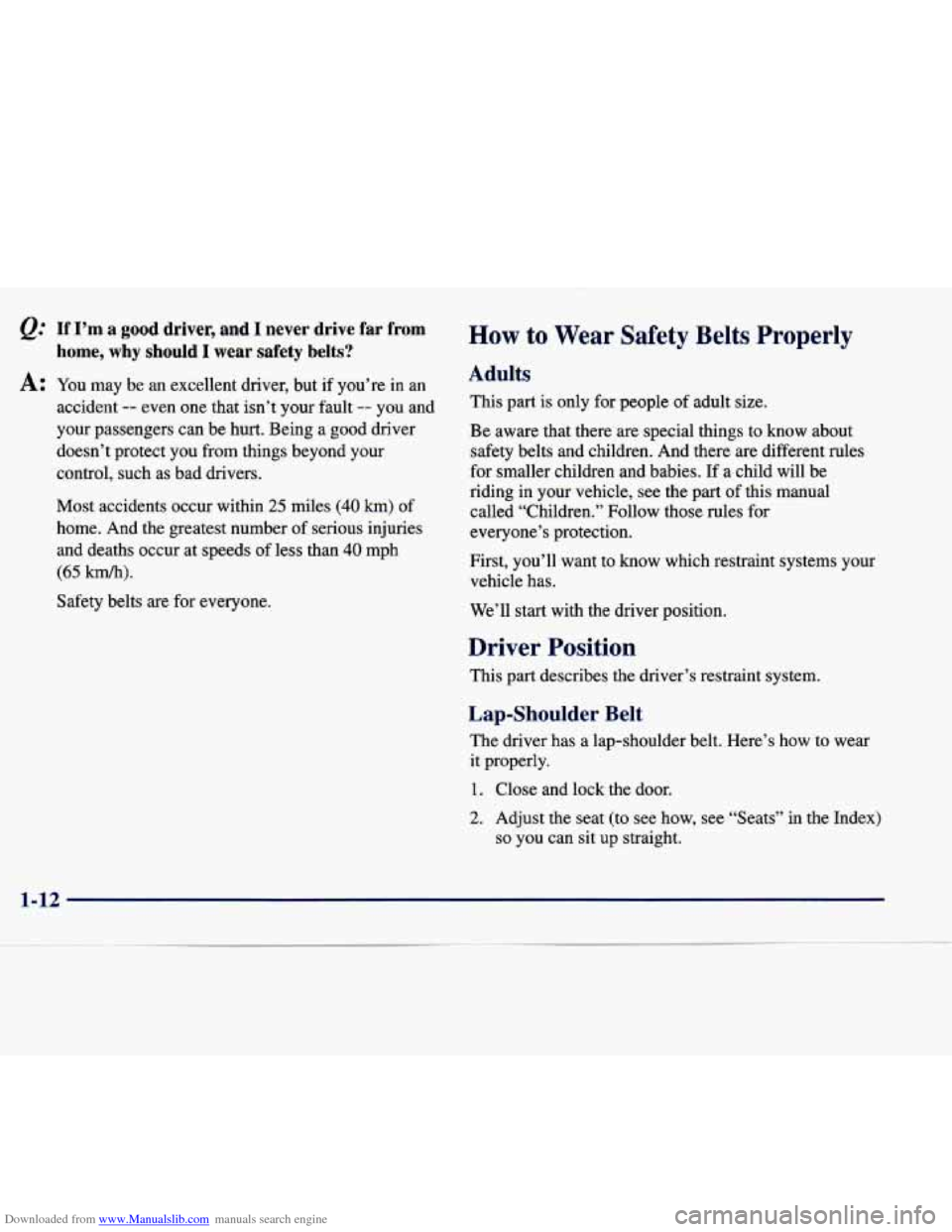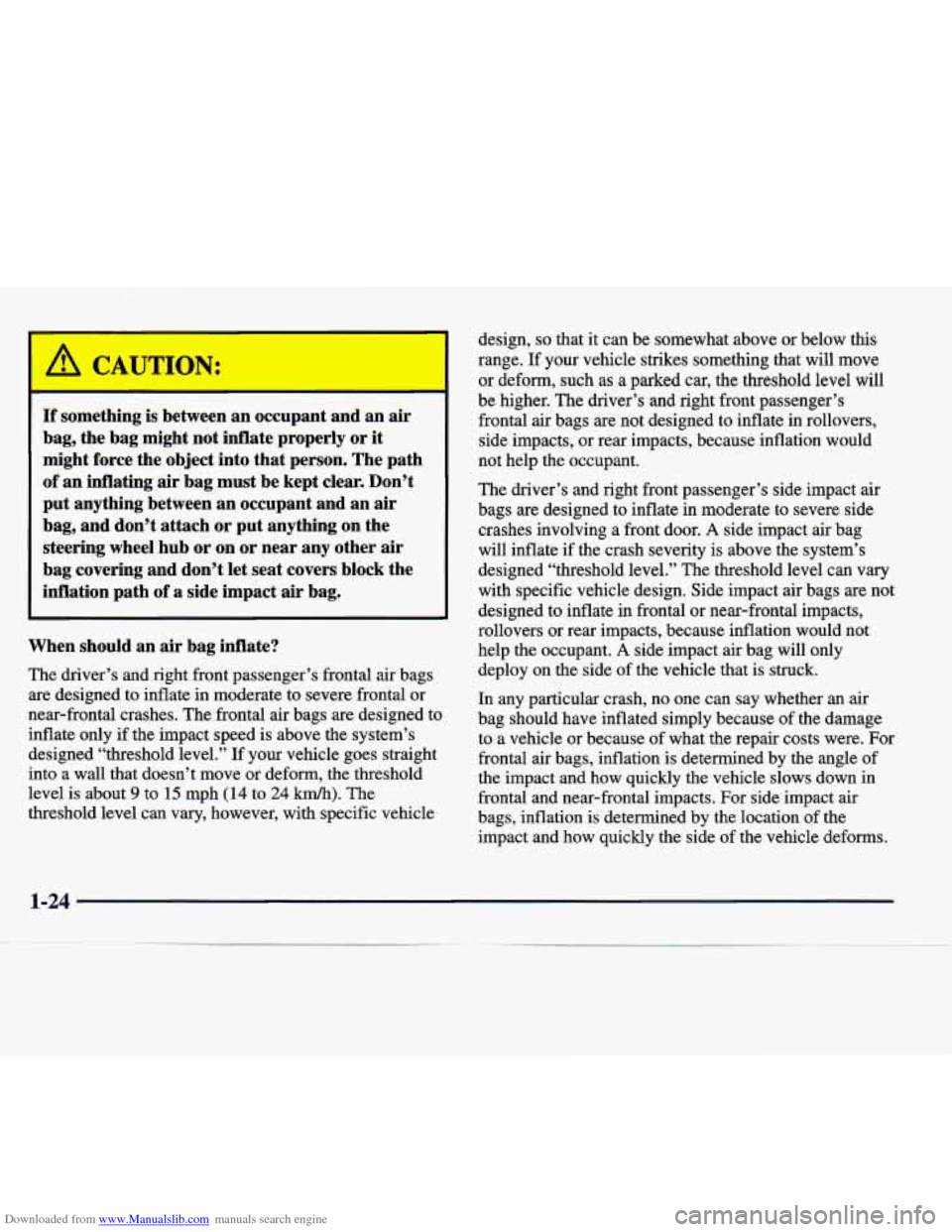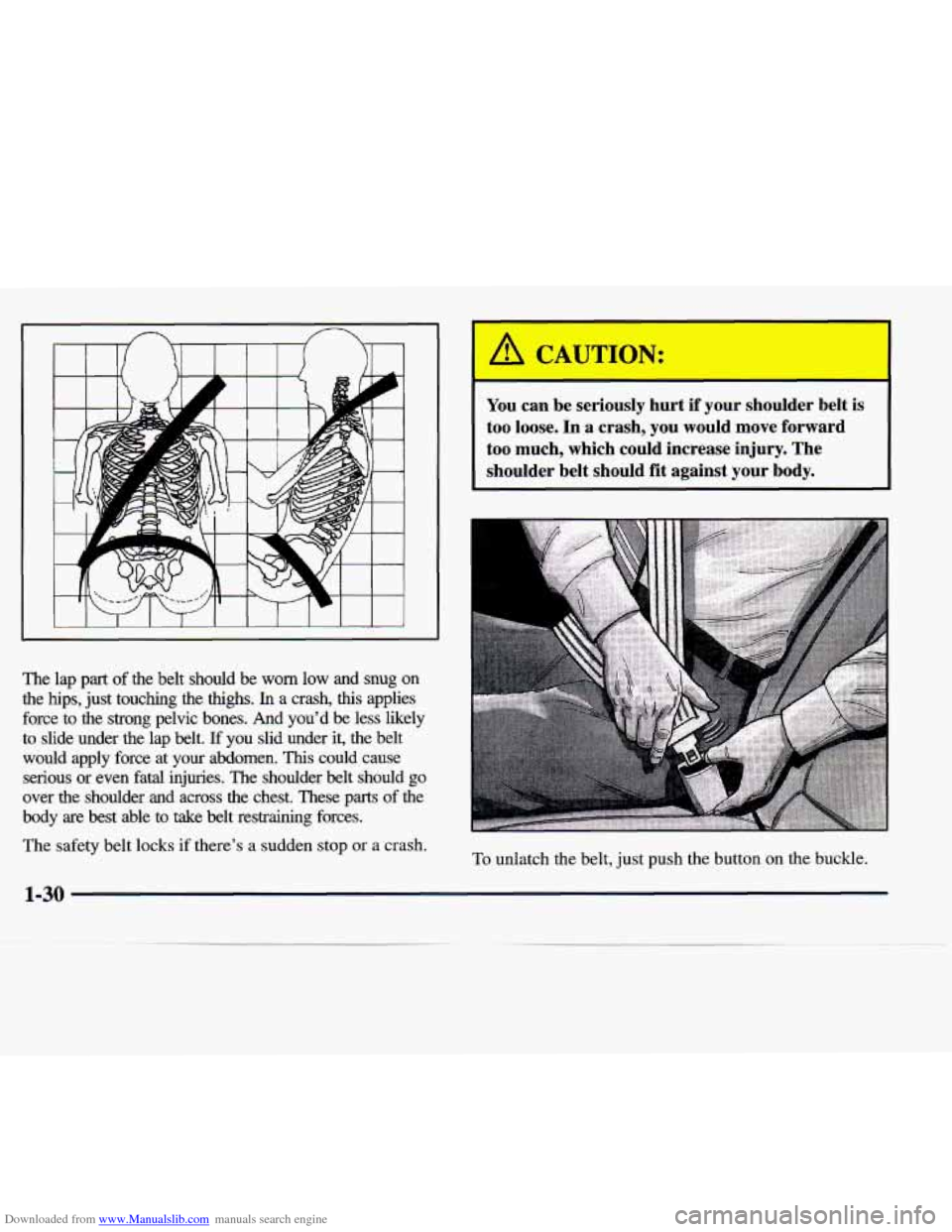1998 CADILLAC SEVILLE lock
[x] Cancel search: lockPage 2 of 378

Downloaded from www.Manualslib.com manuals search engine (1a--Illzj
rt provides in an ernerg
Free lockout assistancf
Free dead-battery assistan
e out-of-fuel assistanc flat-+ire change
Tranq
Page 10 of 378

Downloaded from www.Manualslib.com manuals search engine L
Vehicle Symbols
These are some of the symbols you may find on your vehicle.
For example,
these symbols are
used on an
original battery:
POSSIBLE A
CAUTION
INJURY
PROTECT EYES BY
SHIELDING
CAUSTIC
BURNS
SPARK
OR ,\I/,
COULD FLAME
EXPLODE BAlTERY
These symbols are important
for you and
your passengers whenever your
vehicle is
driven:
DOOR LOCK
UNLOCK
FASTEN SEAT
BELTS
These symbols have to
do with
your lamps:
SIGNALS e e
TURN
FOG LAMPS
# 0
These symbols
are on
some of
your controls:
WINDSHIELD
WIPER
WINDOW
DEFOGGER
These symbols are used on
warning and
indicator lights:
COOLANT -
TEMP -
CHARGING BAllERY
SYSTEM
BRAKE
(0)
COOLANT a
ENGINE OIL e,
PRESSURE
ANTI-LOCK
(a)
BRAKES
Here are some
other symbols
you may see:
FUSE
P
LIGHTER I
HORN be
SPEAKER
12
FUEL B
V
Page 23 of 378

Downloaded from www.Manualslib.com manuals search engine @ If I’m a good driver, and I never drive far from
A: You may be an excellent driver, but if you’re in an
home, why should I wear safety belts?
accident -- even one that isn’t your fault -- you and
your passengers can be hurt. Being a good driver
doesn’t protect you
from things beyond your
control, such as bad drivers.
Most accidents occur within
25 miles (40 km) of
home. And the greatest number of serious injuries
and deaths occur at speeds of less than
40 mph
(65 km/h).
Safety belts are for everyone.
How to Wear Safety Belts Properly
Adults
This part is only for people of adult size.
Be aware that there are special things to know about safety belts and children. And there are different rules
for smaller children and babies. If a child will be
riding in your vehicle, see the part of this manual
called “Children.” Follow those rules for
everyone’s protection.
First, you’ll want to know which restraint systems your vehicle has.
We’ll start with the driver position.
Driver Position
This part describes the driver’s restraint system.
Lap-Shoulder Belt
The driver has a lap-shoulder belt. Here’s how to wear
it properly.
1. Close and lock the door.
2. Adjust the seat (to see how, see “Seats” in the Index)
so you can sit up straight.
1-12
Page 24 of 378

Downloaded from www.Manualslib.com manuals search engine 3. Pick up the latch plate and ~ull the belt across you.
4. Push the latch plate into the buckle until it clicks.
Don’t
let it get
twisted.
Pull up on the latch plate to make sure it is secure.
If
the belt isn’t long enough, see “Safety Belt
Extender” in the Index.
Make sure the release button on the buckle is
positioned
so you would be able to unbuckle the
safety belt quickly if you ever had to. The lap part of the belt should be
worn low and snug on
the hips, just touching the thighs.
In a crash, this applies
force to the strong pelvic bones. And you’d
be less likely
to slide under the lap belt.
If you slid under it, the belt
would apply force at your abdomen.
This could cause
serious or even fatal injuries. The shoulder belt should go
over the shoulder and across the chest. These parts of the
body are
best able to take belt restraining forces.
The safety belt locks
if there’s a sudden stop or crash.
1-13
Page 30 of 378

Downloaded from www.Manualslib.com manuals search engine The best way to protect the fetus is to protect the
mother. When a safety belt is worn properly, it’s more
likely that the fetus won’t be hurt in a crash. For
pregnant women, as for anyone, the key to making
safety belts effective
is wearing them properly.
Right Front Passenger Position
To learn how to wear the right front passenger’s safety
belt properly, see “Driver Position” in the Index.
The right front passenger’s safety belt works the same
way as the driver’s safety belt
-- except for one thing. If
you ever pull the lap portion of the belt out all the way,
you will engage the child restraint locking feature. If
this happens, just let the belt go back all the way and
start again.
Supplemental Inflatable Restraint
(SIR) Systems
This part explains the frontal and side impact
Supplemental Inflatable Restraint (SIR) systems or air
bag systems.
Your vehicle has four air bags -- a “Next Generation”
frontal air bag for the driver, another “Next Generation”
frontal air bag for the right front passenger, a side
impact air bag for the driver, and another side impact air
bag for the right front passenger. Next Generation
frontal air bags are designed to help reduce the risk of
injury from the force of an inflating frontal air bag. But
even these air bags must inflate very quickly if they
are
to do their job and comply with federal regulations.
1-19
Page 35 of 378

Downloaded from www.Manualslib.com manuals search engine A CAUTION:
If something is between an occupant and an air
bag, the bag might not inflate properly
or it
might force the object into that person. The path
of an inflating air bag must be kept clear. Don’t
put anything between an occupant and an air
bag, and don’t attach or put anything
on the
steering wheel hub or on or near any other air
bag covering and don’t let seat covers block the
inflation path of a side impact air bag.
When should an air bag inflate?
The driver’s and right front passenger’s frontal air bags
are designed to inflate in moderate to severe frontal or
near-frontal crashes. The frontal air bags are designed to
inflate only if the impact speed is above the system’s
designed “threshold level.” If your vehicle goes straight
into a wall that doesn’t move or deform,
the threshold
level is about
9 to 15 mph (14 to 24 km/h). The
threshold level can vary, however, with specific vehicle design,
so that it can be somewhat above or below this
range. If your vehicle strikes something that will move
or deform, such as a parked car, the threshold level will
be higher. The driver’s and right front passenger’s
frontal air bags are not designed to inflate in rollovers,
side impacts, or rear impacts, because inflation would
not help the occupant.
The driver’s and right front passenger’s side impact air
bags
are designed to inflate in moderate to severe side
crashes involving a front door.
A side impact air bag
will inflate if the crash severity is above the system’s
designed “threshold level.”
The threshold level can vary
with specific vehicle design. Side impact air bags are not
designed to inflate in frontal or near-frontal impacts,
rollovers or rear impacts, because inflation would not
help the occupant.
A side impact air bag will only
deploy on the side of the vehicle that is struck.
In any particular crash, no one can say whether an air
bag should have inflated simply because of the damage to a vehicle or because of what the repair costs were.
For
frontal air bags, inflation is determined by the angle of
the impact and how quickly the vehicle slows down in
frontal and near-frontal impacts. For side impact air
bags, inflation is determined by the location
of the
impact and how quickly the side of the vehicle deforms.
1-24
Page 37 of 378

Downloaded from www.Manualslib.com manuals search engine A CAUTIOD
When a.n air bag inflates, there is dust in the air.
This dust could cause breathing problems
for
people with a history of asthma or other
breathing trouble.
To avoid this, everyone in the
vehicle should get out as
soon as it is safe to do so.
If you have breathing problems but can’t get out
of the vehicle after an air bag inflates, then get
fresh
air by opening a window or a door.
Your vehicle has a feature that will automatically unlock
the doors and turn the interior lamps on when the frontal
air bags inflate (if battery power
is available). You can
lock the doors again and turn the interior lamps off by
using the door lock and interior lamp controls.
In many crashes severe enough to inflate an air bag,
windshields are broken by vehicle deformation.
Additional windshield breakage may also occur from the
right front passenger air bag.
0 Air bags are designed to inflate only once. After an
air bag inflates, you’ll need some new parts for your
air bag system. If you don’t get them, the air bag
system won’t be there to help protect you in another
crash.
A new system will include air bag modules
and possibly other parts. The service manual for your
vehicle covers the need to replace other parts.
0 Your vehicle is equipped with a crash sensing and
diagnostic module, which records information about
the frontal air bag system. The module records information about the readiness of the system, when
the sensors are activated and driver’s safety belt
usage at deployment.
Let only qualified technicians work on your air bag systems. Improper service can mean that an air bag
system won’t work properly. See your dealer
for service.
1-26
Page 41 of 378

Downloaded from www.Manualslib.com manuals search engine The lap part of the belt should be worn low and snug on
the hips, just touching
the thighs. In a crash, this applies
force to the strong pelvic bones.
And you’d be less likely
to slide under the lap belt. If you slid under it, the belt
would apply force at
your abdomen. This could cause
serious or even fatal injuries. The shoulder belt should go
over the shoulder and across the chest. These parts
of the
body are best able to take belt restraining forces.
The safety belt locks if there’s
a sudden stop or a crash.
You can be seriously hurt if your shoulder belt is
too loose. In a crash, you would move forward
too much, which could increase injury. The
shoulder belt should fit against your body.